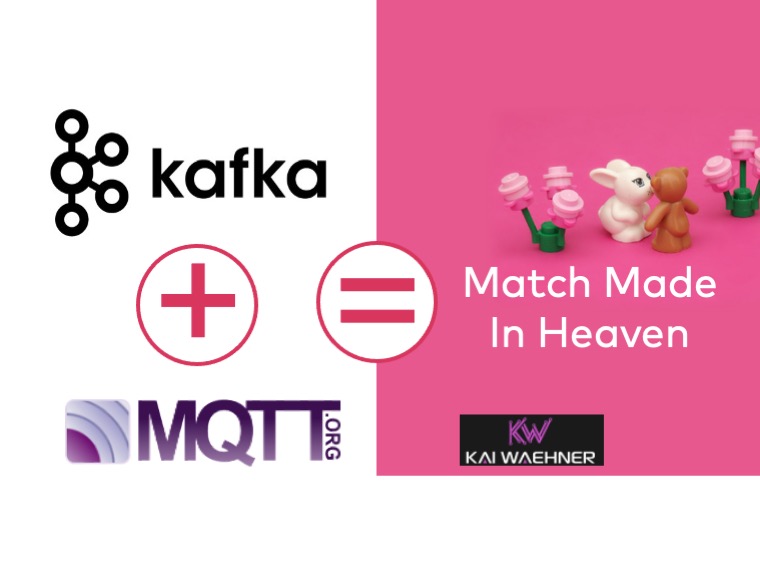
Apache Kafka and MQTT are a perfect combination for many IoT use cases. This blog series covers the pros and cons of both technologies. Various use cases across industries, including connected vehicles, manufacturing, mobility services, and smart city are explored. The examples use different architectures, including lightweight edge scenarios, hybrid integrations, and serverless cloud solutions. This post is part one: Overview and Comparison.

Gartner predicts: “Around 10% of enterprise-generated data is created and processed outside a traditional centralized data center or cloud. By 2025, this figure will reach 75%“. Hence, looking at the combination of MQTT and Kafka makes a lot of sense!
The first blog post explores the relation between MQTT and Apache Kafka. Afterward, the other four blog posts discuss various use cases, architectures, and reference deployments.
Subscribe to my newsletter to get updates immediately after the publication. Besides, I will also update the above list with direct links to this blog series’s posts as soon as published.
MQTT is an open standard for a publish/subscribe messaging protocol. Open source and commercial solutions provide implementations of different MQTT standard version. MQTT was built for IoT use cases, including constrained devices and unreliable networks. However, it was not built for data integration and data processing.
Contrary to the above, Apache Kafka is not an IoT platform. Instead, Kafka is an event streaming platform and used the underpinning of an event-driven architecture for various use cases across industries. It provides a scalable, reliable, and elastic real-time platform for messaging, storage, data integration, and stream processing.
To clarify, MQTT and Kafka complement each other. Both have their strength and weaknesses. They typically do not compete with each other.
This section explores the trade-offs of both technologies.
Pros of MQTT
Cons of MQTT
Pros of Kafka
Cons of Kafka
Choose MQTT for messaging if you have a bad network, tens of thousands of clients, or the need for a lightweight push-based messaging solution, then MQTT is the right choice. Elsewhere, Kafka, a powerful event streaming platform, is probably a great choice for messaging, data integration, and data processing. In many IoT use cases, the architecture combines both technologies.
We have built a “simple demo” with Confluent and HiveMQ running on cloud-native Kubernetes infrastructure. The use case implements data processing from 100,000 connected cars and real-time predictive maintenance with TensorFlow:
More details, a video of the demo, and the code are available on Github: 100,000 Connected Cars and Predictive Maintenance in Real-Time with MQTT, Kafka, Kubernetes, and TensorFlow.
Additionally, I blogged a lot about Kafka and Machine Learning. For instance, take a look at streaming machine learning without a data lake with Kafka and TensorFlow.
I already created a lot of material (including blogs, slides, videos) around Kafka and MQTT. Check this out if you need to learn about the different broker alternatives, integration options, and best practices for the combination.
The following slide deck covers the content of this blog series on a high level:
Click on the button to load the content from www.slideshare.net.
In conclusion, Apache Kafka and MQTT are a perfect combination for many IoT use cases. Follow the blog series to learn about use cases such as connected vehicles, manufacturing, mobility services, and smart city. Every blog post also includes real-world deployments from companies across industries. It is key to understand the different architectural options to make the right choice for your project.
What are your experiences and plans in IoT projects? What use case and architecture did you implement? Let’s connect on LinkedIn and discuss it! Stay informed about new blog posts by subscribing to my newsletter.
The telecommunications industry is transforming rapidly as Telcos expand partnerships with MVNOs, IoT platforms, and…
Mobility services like Uber, Grab, and FREE NOW (Lyft) rely on real-time data to power…
The rise of Electric Vehicles (EVs) demands a scalable, efficient charging network—but challenges like fluctuating…
Apache Kafka 4.0 represents a major milestone in the evolution of real-time data infrastructure. Used…
Agentic AI marks a major evolution in artificial intelligence—shifting from passive analytics to autonomous, goal-driven…
Industrial enterprises face increasing pressure to move faster, automate more, and adapt to constant change—without…